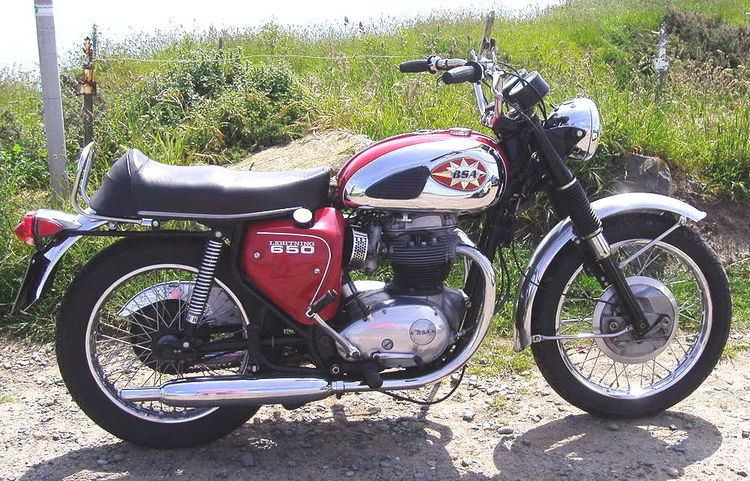Also called A65L Top speed 112 mph (180 km/h) | Production 1965–1972 | |
 | ||
Engine 654 cc (39.9 cu in) OHV parallel twin | ||
The BSA Lightning was a British BSA 650 cc-class motorcycle made in Birmingham between 1965 and 1972.
Contents
Development
The BSA Lightning was designed as the all-round sports machine of the 1960s, planned largely for export to the US market to complement the touring Thunderbolt and the later development, the supersports Spitfire. Development of the engine aimed to make it more reliable, quieter and less prone to oil leaks, with top speed sacrificed to improve mid-range and rideability. Nevertheless, with twin carburettors the A65L could still reach 108 mph (174 km/h). Improvements included an oil pressure warning light, but this had a tendency to malfunction, so riders learned to ignore it.
A close ratio gearbox combined with a high lift camshaft made for lively acceleration and performance at higher rpm than the standard A65. The bottom gear was a bit high, however, so riders had to learn to slip the clutch up to 10 mph (16 km/h). Above 5000 rpm customers also complained about excessive vibration, with a tendency to weave above 90 mph (140 km/h).
A useful feature was an 'emergency starting' key position for times when the battery was flat to connect the alternator current directly to the ignition coils.
From 1969 the Lightning was improved with balanced exhaust pipes, redesigned silencer-internals, widened crankcase-half mating faces and a twin leading shoe front brake. When road testing, Motorcycle Sport found the natural cruising speed to be 70 mph (110 km/h), but was impossible to ride comfortably at more 5,500 rpm in the higher gears due to severe vibration, with 6,200 revs repeatedly breaking the headlamp bulb filament; accordingly no top speed runs were attempted.
In 1971, 201 750cc versions, designated the A70L, were also produced for American racing homologation purposes.
In 1972 the BSA Group were in financial difficulties and, in a last attempt to extend the brand life, a new frame was developed for the A65L. As well as raising the seat height to an impractical 33 inches (840 mm), it actually broke during testing at the Motor Industry Research Association (MIRA) test track, marking the end of one of the most successful range of British twin cylinder motorcycles.
Thunderball BSA Lightning
A fully faired BSA Lightning fitted with missiles featured in the 1965 James Bond film Thunderball. ridden by the late Bill Ivy, then a UK motorcycle champion, wearing a blond wig to make him look like Bond girl Fiona Volpe, played by Italian actress Luciana Paluzzi. Volpe used the gold-painted BSA to fire two rocket missiles and destroy Count Lippe's car, which was chasing Bond.
A working missile launching system was fitted to the motorcycle but the explosion which destroyed the car was actually detonated remotely by stunt coordinator Bob Simmons. The filming of the scene was recorded in a Ford Motor Company film A Child's Guide to Blowing Up a Motor Car that is on the Ultimate DVD edition of Thunderball.
The actual bike was exhibited at Brighton motorcycle show held at the Metropole Hotel exhibition centre in September 1965.
Cinema film 'if....'
The Lightning featured in the 1968 film 'if....' starring Malcolm McDowell who, as the main character 'Mick' – purporting to be a potential buyer of a motorcycle – proceeded to start the bike and ride out of the dealer's showroom on a joyous, reckless spree, a practice generally known as 'joy riding'.
Boon TV Series
One of the Lightning's claims to fame is that it was extensively used in the hit British TV series Boon, shown from 1986. The beautiful Lightning (nicknamed 'White Lightning' by the main character, Ken Boon) was a major part of the series' popularity for the 7-year run. Boon - who thought of himself as a modern day Lone Ranger – would treat his Lightning as though it was his horse.
